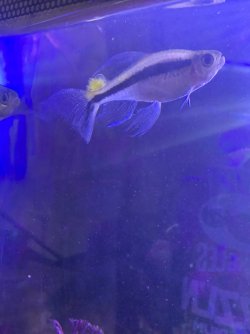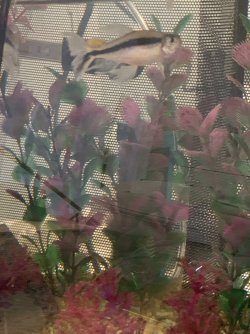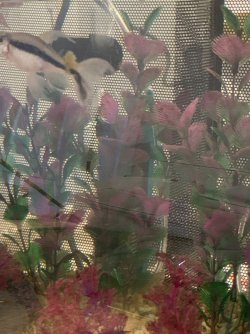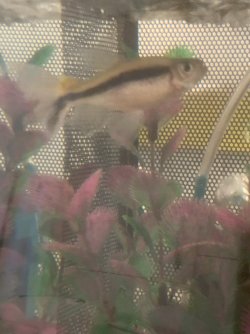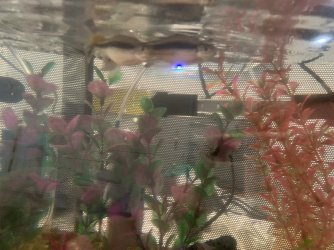You are using an out of date browser. It may not display this or other websites correctly.
You should upgrade or use an alternative browser.
You should upgrade or use an alternative browser.
New member help with my fish
- Thread starter Specs09
- Start date
April FOTM Photo Contest Starts Now!

🏆 Click to enter! 🏆
Hi and welcome to the forum 
Can we get some more pictures but under white light (not blue), and maybe a 1 minute video?
You can upload videos to YouTube, then copy & paste the link here.
If you use a mobile phone to film the fish, hold the phone horizontally so the footage fills the entire screen.
-----------------
If could be fungus on the adipose fin (2nd fin on its back). You can try salt and if there's no improvement after a couple of days, then post more pictures.
-----------------
SALT
You can add rock salt (often sold as aquarium salt) or swimming pool salt to the aquarium at the dose rate of 1 heaped tablespoon per 20 litres of water. If there is no improvement after 48 hours you can double that dose rate so there is 2 heaped tablespoons of salt per 20 litres.
Keep the salt level like this for at least 2 weeks but no longer than 4 weeks otherwise kidney damage can occur. Kidney damage is more likely to occur in fish from soft water (tetras, Corydoras, angelfish, Bettas & gouramis, loaches) that are exposed to high levels of salt for an extended period of time, and is not an issue with livebearers, rainbowfish or other salt tolerant species.
The salt will not affect the beneficial filter bacteria, fish, plants, shrimp or snails.
After you use salt and the fish have recovered, you do a 10% water change each day for a week using only fresh water that has been dechlorinated. Then do a 20% water change each day for a week. Then you can do bigger water changes after that. This dilutes the salt out of the tank slowly so it doesn't harm the fish.
If you do water changes while using salt, you need to treat the new water with salt before adding it to the tank. This will keep the salt level stable in the tank and minimise stress on the fish.
When you first add salt, add the salt to a small bucket of tank water and dissolve the salt. Then slowly pour the salt water into the tank near the filter outlet. Add the salt over a couple of minutes.
Can we get some more pictures but under white light (not blue), and maybe a 1 minute video?
You can upload videos to YouTube, then copy & paste the link here.
If you use a mobile phone to film the fish, hold the phone horizontally so the footage fills the entire screen.
-----------------
If could be fungus on the adipose fin (2nd fin on its back). You can try salt and if there's no improvement after a couple of days, then post more pictures.
-----------------
SALT
You can add rock salt (often sold as aquarium salt) or swimming pool salt to the aquarium at the dose rate of 1 heaped tablespoon per 20 litres of water. If there is no improvement after 48 hours you can double that dose rate so there is 2 heaped tablespoons of salt per 20 litres.
Keep the salt level like this for at least 2 weeks but no longer than 4 weeks otherwise kidney damage can occur. Kidney damage is more likely to occur in fish from soft water (tetras, Corydoras, angelfish, Bettas & gouramis, loaches) that are exposed to high levels of salt for an extended period of time, and is not an issue with livebearers, rainbowfish or other salt tolerant species.
The salt will not affect the beneficial filter bacteria, fish, plants, shrimp or snails.
After you use salt and the fish have recovered, you do a 10% water change each day for a week using only fresh water that has been dechlorinated. Then do a 20% water change each day for a week. Then you can do bigger water changes after that. This dilutes the salt out of the tank slowly so it doesn't harm the fish.
If you do water changes while using salt, you need to treat the new water with salt before adding it to the tank. This will keep the salt level stable in the tank and minimise stress on the fish.
When you first add salt, add the salt to a small bucket of tank water and dissolve the salt. Then slowly pour the salt water into the tank near the filter outlet. Add the salt over a couple of minutes.
Specs09
New Member
HiHi and welcome to the forum
Can we get some more pictures but under white light (not blue), and maybe a 1 minute video?
You can upload videos to YouTube, then copy & paste the link here.
If you use a mobile phone to film the fish, hold the phone horizontally so the footage fills the entire screen.
-----------------
If could be fungus on the adipose fin (2nd fin on its back). You can try salt and if there's no improvement after a couple of days, then post more pictures.
-----------------
SALT
You can add rock salt (often sold as aquarium salt) or swimming pool salt to the aquarium at the dose rate of 1 heaped tablespoon per 20 litres of water. If there is no improvement after 48 hours you can double that dose rate so there is 2 heaped tablespoons of salt per 20 litres.
Keep the salt level like this for at least 2 weeks but no longer than 4 weeks otherwise kidney damage can occur. Kidney damage is more likely to occur in fish from soft water (tetras, Corydoras, angelfish, Bettas & gouramis, loaches) that are exposed to high levels of salt for an extended period of time, and is not an issue with livebearers, rainbowfish or other salt tolerant species.
The salt will not affect the beneficial filter bacteria, fish, plants, shrimp or snails.
After you use salt and the fish have recovered, you do a 10% water change each day for a week using only fresh water that has been dechlorinated. Then do a 20% water change each day for a week. Then you can do bigger water changes after that. This dilutes the salt out of the tank slowly so it doesn't harm the fish.
If you do water changes while using salt, you need to treat the new water with salt before adding it to the tank. This will keep the salt level stable in the tank and minimise stress on the fish.
When you first add salt, add the salt to a small bucket of tank water and dissolve the salt. Then slowly pour the salt water into the tank near the filter outlet. Add the salt over a couple of minutes.
Thank you I’ve taken a video the way you asked but won’t let me attach I’ve taken a few more pictures sorry my phone is an oldish apple and camera not very good.
Thank you for your help
Sharon
Attachments
That's weird. Never seen anything like that before.
Specs09
New Member
She had the tank for 2 years I’ve had it two weeks we transported all the water she had in it. I’m a total novice only ever had gold fish and seen popeye before and treated.Welcome to TFF.
How long has the tank been set up? Is it cycled?
The tank has a filter, light and heater.
Sharon
Specs09
New Member
They are in the post so hopefully here tomorrow or Wednesday.Do you have a test kit?
One key fundamental of fishkeeping is knowing your tank water parameters (ammonia, nitrIte, NitrAte, and ph)
Good to know...run those test, post your results here...that's the first step in determining if the tank water is safe for your fishThey are in the post so hopefully here tomorrow or Wednesday.
That being said, I'm no expert on fish diseases, and have no clue what that "growth" may or may not be
Videos must be uploaded to a video hosting site such as YouTube and the link posted on here.I’ve taken a video the way you asked but won’t let me attach
I can't tell much from the pictures (not in focus).
Could be fungus but wrong colour. However, there aren't any fish diseases that are yellow and fluffy.
Do you have any yellow sponge or filter floss in the tank?
I would try the salt and see how it goes in a few days.
Could be fungus but wrong colour. However, there aren't any fish diseases that are yellow and fluffy.
Do you have any yellow sponge or filter floss in the tank?
I would try the salt and see how it goes in a few days.
Latest Discussions
- Replies
- 6
- Views
- 38
- Replies
- 10
- Views
- 191
trending
-
-
-
-
-
F-1 Angel... a bit nervous... it'll be my 1st F-1 fish...
- Started by Magnum Man
- Replies: 17
Staff online
-
FishmanicTFF Contest Czar
-
emeraldkingModerator
Members online
Total: 563 (members: 10, guests: 553)

